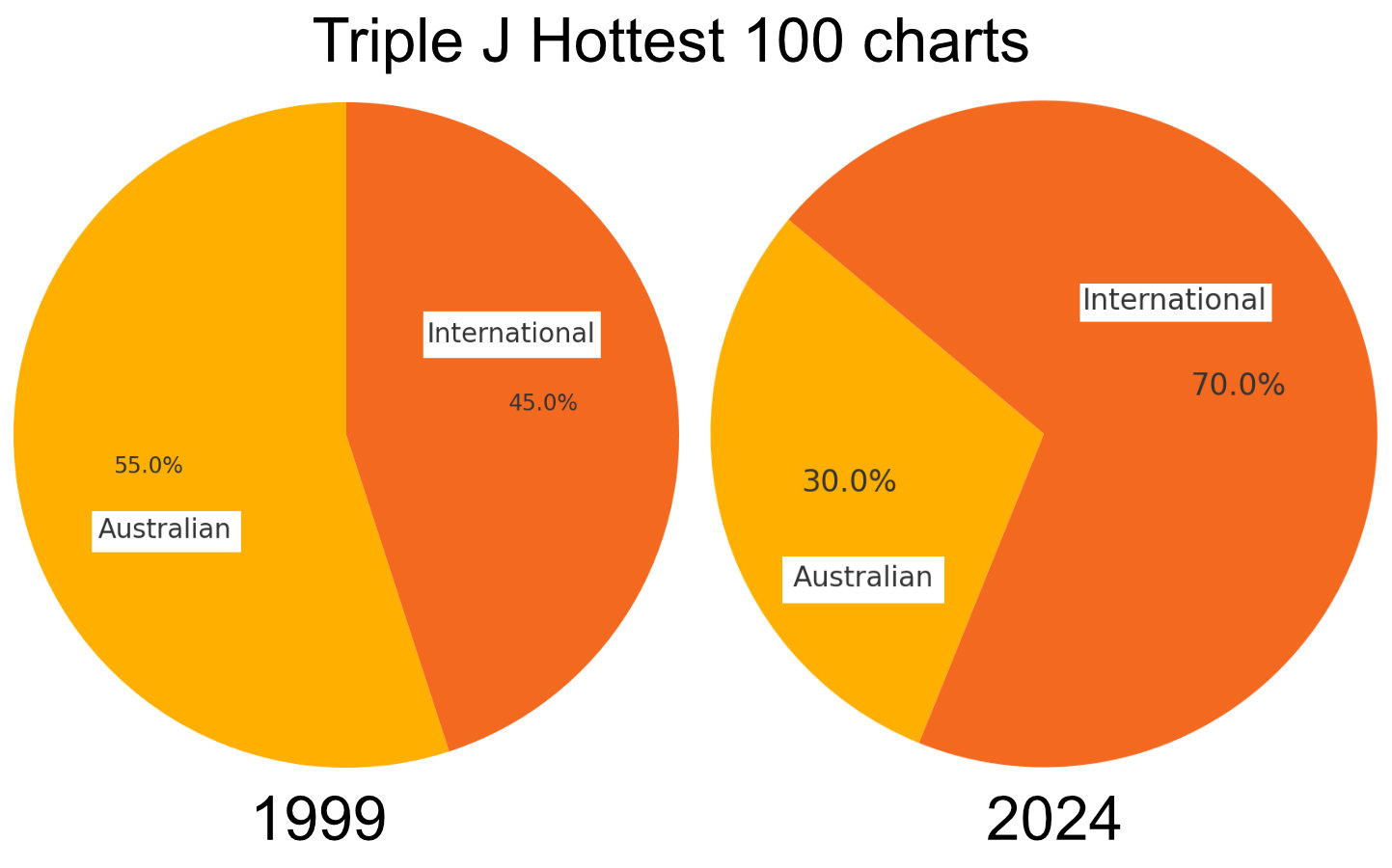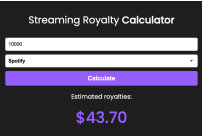Streaming algorithms, the power of major labels, and foreign-owned radio stations are drowning out homegrown music talent. Joshua Barnett with the story.
Australia’s music identity has a history of vibrant and energetic bands. However, recent trends on Triple J’s Hottest 100 suggest that international record labels might be tightening their grip on the market. Only 29 Australian tracks made it into the 2024 countdown, the lowest since 1996.
Is Triple J is losing Australian soul?
This year, American artist Chappell Roan’s Good Luck, Babe! secured the top spot, while Sydney’s Royel Otis managed a strong showing at #2 with their cover of Murder on the Dancefloor (which isn’t an Australian song).
Compare this to, say, 1999, a watershed year when Powderfinger’s These Days topped a chart dominated by 52 Australia entries. Back then, Aussie artists reigned supreme, reflecting a time when Triple J was synonymous with local pride and discovery.

This is not a comparison to whether or not Australian music has gotten better or worse over the years. The issue is the ever-increasing market dominance of mainly USA-based artists backed by major labels being pushed by our national radio stations, social media and even our national broadcaster, the ABC.
1999, a watershed year when Powderfinger’s These Days topped a chart dominated by 52 Australia entries
The ARIA’s point to a broader crisis
The Hottest 100’s decline in Australian representation isn’t an isolated issue. The Australian Recording Industry Association, ARIA’s 2024 year-end charts paint an even grimmer picture.
Not a single Australian song released in 2024 made the Top 100 singles chart.
The only homegrown albums to crack the year-end Top 100 were greatest hits compilations from Cold Chisel and INXS, alongside rapper The Kid LAROI’s The First Time. The album chart’s highest new release by an Australian act, Amyl & The Sniffers’ Cartoon Darkness, did not even make the cut, although it did make the Hottest 100 at #34 and #32.
In the ARIA singles chart, Australians accounted for just 5% of entries. On the albums chart, it was a dismal 3%.
Addressing this, ARIA CEO Annabelle Herd told The Music Network, “A lack of Australian artists reflected in the end-of-year charts is unfortunately not new news. Given the long discourse between ARIA, the industry, and media around this and what can be done to shift it, the annual chart result should come as no surprise.”
Herd’s statement reflects the entrenched nature of the issue and highlights the ongoing challenges in ensuring local talent gains visibility in a globalised and highly competitive market.
International labels dominate
A major part of the problem lies with international record labels, which dominate both ARIA and the Hottest 100.
These global giants prioritise their international rosters, relegating local artists to an afterthought. Despite Triple J’s Unearthed program and efforts to feature over 50% Australian music in its weekly rotation, the Hottest 100 results suggest a disconnect between airtime and actual listener engagement.
Adding to this challenge is the ownership structure of Australian radio stations, where foreign stakeholders hold significant sway.
Reports from the Australian Communications and Media Authority (ACMA) reveal that companies like ARN Med Limited and Southern Cross Media Group, which own substantial numbers of radio licenses, also have significant foreign ownership.
Compounding the issue are streaming algorithms, heavily influenced by international playlists, which skew listener habits towards global hits. ARIA’s reliance on streaming data as a metric for chart success has further entrenched overseas dominance, masking it as an Australian preference.
The combined effect is a system where international interests eclipse opportunities for local talent, eroding the cultural foundation of Australian music.
Is Ticketek fleecing Australian artists, audiences, for the Caymans and California?
The algorithm disadvantage
Streaming platforms like Spotify, TikTok, and Meta dominate how music is consumed globally, and their algorithm-driven recommendations increasingly prioritise international artists.
In Australia, this has created an uphill battle for local musicians to gain visibility.
Despite efforts by Australian artists to adapt to the “TikTokification” of music – where short, viral-read content reigns supreme – international record labels, backed by lucrative deals with these platforms, hold the upper hand.
Warner Music Group’s licensing agreement with Meta ensures its global roster dominates feeds while independent Australian acts struggle to break through the noise.

Spotify royalty calculator
TikTok’s algorithms, in particular, have transformed music promotion, but often at a significant cost to artists. Viral success on the platform rarely translates to financial gain, as Melbourne-based artist Grace Frost highlighted, receiving only $0.20 for 110,000 streams.
Platforms claim to support artists by providing exposure, but with limited compensation and a focus on international acts, many Australian musicians are left feeling like “unpaid interns.” This imbalance reinforces global dominance, leaving local talent further marginalised.
Are Australian listeners to blame?
Australian music ranks third in local streaming preferences, with just 9.2% of streams attributed to homegrown acts, compared to a staggering 61.2% for U.S. artists.
This imbalance is exacerbated by social media algorithms, which amplify trending songs, typically backed by international record labels, through viral challenges and playlist placements.
Discoverability and accessibility of local music are key to the success of Australian Artists, but breaking through the algorithmic dominance of international playlists is a monumental challenge.
The result is a vicious cycle: global labels secure deals with platforms that prioritise their catalogues, shaping audience habits and reinforcing the hegemony of international music. Without meaningful interventions,
Australian artists face a cultural and commercial marginalisation that threatens the long-term health of the nation’s music industry.
Industry response
The Australian music industry faces a crisis, with international labels and streaming algorithms dominating, while homegrown acts struggle for visibility.
ARIA and government initiatives like ARIA Amplified and Great Southern Nights aim to counter this through funding, content quotas, and strategic export programs, but systemic barriers remain.
Soaring costs, venue closures, and a lack of industry-wide commitment to prioritising Australian talent continue to undermine local artists.
Stronger policies, better funding models, and a shift in audience behaviour are crucial to reversing this decline.
Australian music isn’t lacking in quality, it’s lacking exposure.
In our upcoming video and story, we’ll explore tangible solutions, from government intervention to industry-led reforms, and what it will take to restore local artists to the spotlight. Stay tuned.
Josh is a professional musician and cameraman who is now working with Michael West Media to develop The West Report and other visual content across major social media channels

